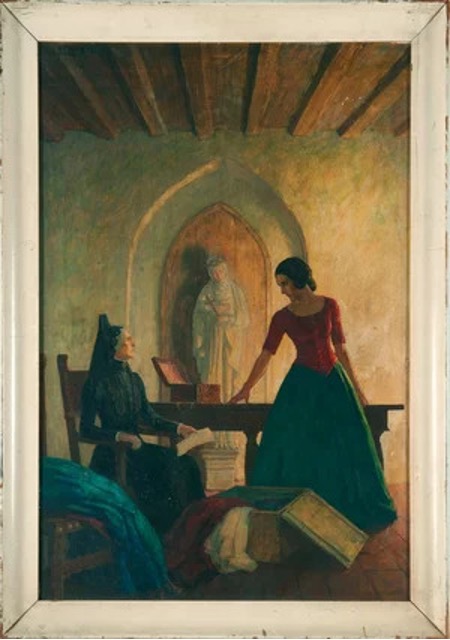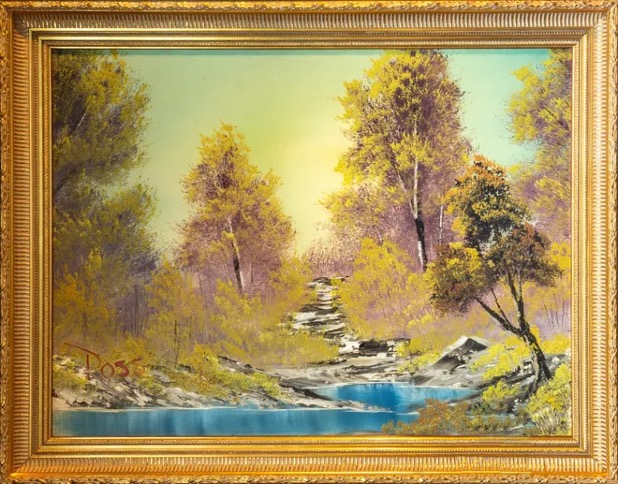Two stories about art captured the general attention this past month. The first embodied every thrift store visitor’s dream, something that has kept the Antiques Roadshow franchise in business since 1977. It invites visions of “That could happen to me!”
A woman who has remained anonymous was browsing in a New Hampshire thrift shop in 2017. Poking through a dusty stack of paintings in search of an old frame that she might restore, the shopper came across a painting of two women in conversation. Liking the antique frame, she purchased the piece for four dollars and stuck it in a closet at home until she had time to deal with it. When she finally examined the painting carefully, she found a label on the back with the name N.C. Wyeth and another label mentioning a book called Ramona.

N.C. Wyeth. Senora Gonzaga Moreno and Ramona.
Photo courtesy Bonhams Skinner.
The owner did some online research and discovered that the painting was indeed by Newell Convers Wyeth (1882-1945), one of the foremost artists who worked in the Brandywine region of Pennsylvania, and the father of Andrew Wyeth. Wyeth was a popular book illustrator in the first half of the 20th century, and this painting had served as the frontispiece for the novel Ramona by Helen Hunt Jackson, a 19th century writer and early crusader for the rights of Native Americans.
N.C. Wyeth is a big deal for collectors of American illustrators today. Thirteen of his paintings have sold at auction for over a million dollars. The highest price, just under $6 million, was achieved at Sotheby’s five years ago.
While Ramona was a popular book and was reprinted many times, it has not remained famous, unlike Robert Louis Stevenson’s Kidnapped or the stories of Robin Hood and Rip Van Winkle, all of which Wyeth illustrated. An illustration for Ramona, therefore, was not going to bring anything like one of those illustrations would bring. Bonhams Skinner in Marlborough, Massachusetts, the auction house to which the new owner consigned the work to sell, was appropriately cautious in placing an estimate of $150,000-250,000 on the piece.
The work was offered at Bonhams Skinner on September 19. There was only one bid, at the low estimate, but that was enough. With buyer’s premium added, the work sold for $191,000. It is important to note that the buyer’s premium goes to the auction house, not the seller, who also pays a commission to the auction house, normally 10%. After deducting the buyer’s premium and the sales commission, therefore, the owner probably realized about $135,000 from the sale.
$135,000 is a nifty return on investment for a four-dollar purchase, which is what caused the extensive coverage of the sale in the general news media. I have written before about the dream of coming across such a find (see previous blog here). The fact that the Wyeth above was in a thrift shop, not an auction, allowed the buyer to make this coup. Had the venue been a small New England auction instead of a thrift shop, and had the work been reproduced online as part of their upcoming sales, any number of knowledgeable individuals would have seen it, recognized it as something worth investigating, and hurried to bid.
Napoleon once said that he’d rather have a lucky general than a smart one. This buyer lucked out.
On January 11, 1983, a PBS station in Falls Creek, Virginia, aired a show on learning to paint. Bob Ross, the genial host, demonstrated how to paint a wooded landscape using only a stiff brush and a palette knife. The show was a hit and soon gained a following, lasting until 1994. Its syndication made Ross, who died in 1995, a national figure. Ross went on to paint more than 400 works on the air. A Walk in the Clouds, the painting from that first show, was sold soon after the first show at a benefit auction to raise funds for the television station.

Bob Ross. A Walk in the Woods.
Photo courtesy Pavlica Photography and Modern Artefact.
Flash forward 40 years: Modern Artefact, a Minneapolis gallery, acquired the painting a year ago and has now put it up for sale for $9,850,000. Ryan Nelson, the gallery’s owner, has admitted that the price is a “not for sale” price; that is, he doesn’t expect anyone to step up immediately and buy the painting. He says he’s content to wait.
He’ll probably have a long wait. AskArt lists only four Bob Ross paintings that have been offered at auction. One of those failed to sell with an estimate of $6,000-9,000 at an auction house in Lynbrook, New York, in 2019. But things are picking up. The record price for a Ross painting, $41,000, was achieved at an auction in Valparaiso, Indiana, in January of this year. A painting sold for $23,000 at a St. Petersburg auction house in April, and a small painting sold for $10,240 just this month in New Orleans.
Those venues are a far cry from Sotheby’s, Christie’s, and the other major auction houses, and I don’t expect to see Bob Ross’s paintings hung alongside those of Andy Warhol, Jeff Koons, or any other blue-chip contemporary artist in major museums anytime soon. “What this piece represents is the people’s artist,” Ryan Nelson says. “This isn’t an institution that’s telling you that Bob Ross is great. It’s not some high-brow gallery telling you that Bob Ross is great. This is the masses, the population in the world that are saying that Bob Ross is great.”
Well, the masses do get a vote, as I recently wrote (see blog here). But the masses generally don’t have big bucks. We’ll see if the current hoopla translates into a seven-figure market for Ross. If Nelson can get even a million dollars for the first TV painting Bob Ross ever did, then that painting is worth a million dollars – today. Nostalgia, however, goes only so far. Before you liquidate your retirement fund and put everything into paintings by Bob Ross (or any other artist), give me a call and let’s talk.

